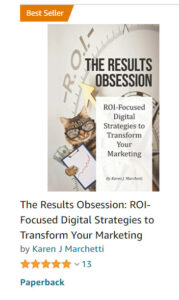“On the NINTH Day of digital marketing planning, your boss will ask of you . . . NINE Lead Generation Strategies . . .
EIGHT Google Ads PPC Success Secrets . . . SEVEN Email Guidelines . . . SIX Website Improvements . . . FIVE Lead Capture Strategies . . . FOUR SEO Factors . . . THREE Design Directives . . . TWO Website Questions . . . and ONE Measurable Marketing Plan . . .”
If the main objective of your website is to generate leads, here’s are the key elements to know and review:
1. Is the focus of your website all about your Offer?
If the entire purpose of your website is to generate leads . . . do you have a Lead Generation Offer on Home, every Product/Service page, and every blog post?
Are you relying on “sign up for our enewsletter”? If so, create a more compelling Offer that helps educate your audience about your product or service. If you’re relying on “Contact Us”, you’ll miss capturing contact information from about 98% of your visitors.
Focus on a valuable Offer that will really be attractive to your audience, so you get the maximum number of visitors to take advantage of it.
2. Have you quantified your lead goals to create a realistic marketing budget?
Do you have a sales force that needs a steady stream of leads to call? Maybe you have a revenue goal, or you want a specific number of new customers.
Look at your conversion rate at each step in your sales process. Work backwards to figure out the number of leads you need to start with.
Then using your average Cost Per Lead, determine the budget you’ll need to hit your lead goal. This is the way to establish a realistic marketing budget (or a useful analysis to share with management to talk about more realistic sales goals).
3. Are you making the right Lead Generation Offer based on your goals?
Maybe you’re looking to build a large database of leads for email follow-up. That “quantity” objective would require a low-commitment Offer with broad appeal.
Or maybe you need to identify the “A” leads who have a budget allocated and are ready to purchase. Offer a special benefit for talking to a Sales Rep.
You may need to gather highly qualified leads for your sales force, so they won’t be wasting their time with follow-up. In this case, you need a medium-commitment Offer more tightly-focused around your product or service.
Review the Offers you’re making in relation to your specific goals, to see if you may need to plan some different Offers.
4. Do you have Offers to attract A, B, and C leads?
“A” leads are ready to buy. “B” leads are actively researching (or searching for a solution), but they’re not ready to buy today. “C” leads are the “sight-seers” ̶ they’re interested, but they don’t have a budget or timeframe for a purchase.
You may need to identify all three types of leads. In that case, you might start with a low-commitment Offer to attract the widest quantity of leads. Then, use your email conversion series to get your “A” leads to raise their hands. With email, educate your “B” leads and create follow-up Offers to help you identify those who are actively searching for a solution.
5. Do you have low commitment Offers for each Buyer Persona?
What’s a low-commitment Offer? It has broad appeal and is easy to get. Document downloads can be low-commitment ̶ if you ask only a few pieces of information to get them.
So, if you’re looking for a large quantity of leads, start with a low-commitment Offer. Be sure your response form only asks for the most critical pieces of information you’ll need to make your email series work (probably email address, first name, and maybe one additional field to help you tailor your message and Offers).
6. Do you consider Lead Quality versus Lead Quantity when crafting your Offers?
Lead Quality and Lead Quantity have an inverse relationship, based on the level of commitment of your Offer.
- High Lead Quality usually also means low Lead Quantity. So if your only Offer is “Contact Us” (high commitment), you’ll get very few leads (low quantity). But those that do contact you will really be interested (typically “A” leads).
- High Lead Quantity usually means low Lead Quality. So, if you Offer a very low-commitment Offer, like “enter our drawing,” you’ll get lots of entries. But a large percentage won’t be “in market” for your product now.
When you craft your Offer, consider where you want to be on the Quality/Quantity spectrum.
7. Have you tried these Lead Qualifiers to generate more qualified leads?
If you’re trying to improve Lead Quality:
- Give more information, so your prospects can decide if the solution really meets their needs
- Ask for more information on your form. The more information you ask for, typically the higher the Lead Quality and the lower the Quantity.
- Make your Offer have narrow appeal, so those who are interested in the Offer are the types of prospects you really want to reach.
- Mention price or the price range
- Charge a nominal fee for your samples or your document download.
8. Have you tried these Lead Multipliers to generate a higher quantity of leads?
When you need more leads, consider these options:
- Give less information
- Ask for less information on your form
- Create an Offer with broader appeal
- Offer free samples
- Don’t mention price
9. How much should you invest in a lead?
It depends on how much each lead is worth to you. And you can compute that based on how much each new customer or order is worth to you.
Do you have to make a profit on the initial sale? If so, you’ll need to factor that into your Lead Generation plan.
Can you bring in new customers at breakeven or at a loss? That may make sense for you, if you have repeat or monthly sales, where each customer can become profitable over time.
Always prepare a financial analysis before you commit to a new Lead Generation program. This will help you plan what types of Offers and Lead Generation programs make sense for you.
Did you miss: EIGHT Google Ads PPC Secrets
SEVEN Truths of Email Marketing . . . SIX Website Improvements . . .
FIVE Lead Capture Strategies . . .
FOUR SEO Factors THREE Design Directives TWO Website Questions and ONE Measurable Marketing Plan
If you need more detail on the planning points above, our new BEST-SELLING book, “The Results Obsession: ROI-Focused Digital Strategies to Transform Your Marketing” is now available on Amazon!

Learn more about The Results Obsession and see the Table of Contents
The book includes chapters on Lead Generation Strategy, Lead Generation Offers (dozens!), marketing math, copy to promote your Offer, and more.






Leave A Comment